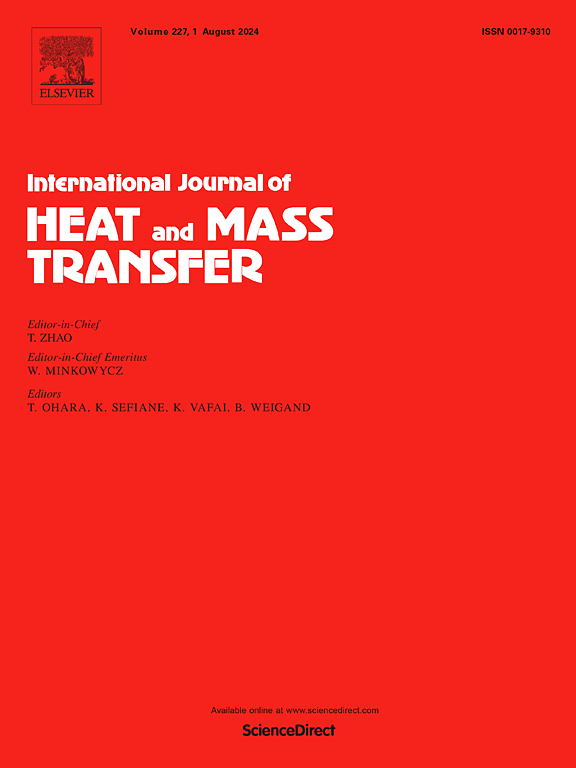Numerical simulation investigating the influence of varied stack parameters on the energy conversion in thermoacoustic engines
IF 5
2区 工程技术
Q1 ENGINEERING, MECHANICAL
International Journal of Heat and Mass Transfer
Pub Date : 2024-10-16
DOI:10.1016/j.ijheatmasstransfer.2024.126305
引用次数: 0
Abstract
The stack is a crucial component of the thermoacoustic heat engine, influencing its capacity to generate stable pressure amplitude and enhance efficiency. Utilizing the discontinuous Galerkin (DG) method, fully compressible Navier–Stokes equations were solved to simulate the energy exchange between the stack and surrounding air under various conditions. (1) Simulations were conducted under different stack wall boundary conditions, including linear temperature distribution wall, isothermal wall, and adiabatic wall. The work performed by 1 kg of gas at a specific position during one cycle was defined as local energy density to analyze the effect of different stack spacing, stack length and stack thickness. (2) Too small a stack spacing causes the inability to generate pressure amplitude. Increasing the stack spacing continuously enhances the generated pressure amplitude, with the energy density distribution near the hot heat exchanger becoming more significant. As the stack spacing continues to increase, the energy density decreases at positions farther from the wall, leading to a reduction in pressure amplitude. The generated acoustic streaming intensity diminishes faster with the continuous increase in stack spacing. (3) A smaller stack length results in reduced viscous dissipation at the wall, leading to a larger generated pressure amplitude. However, shorter stack lengths cause increased gas oscillation displacement, resulting in lower energy density concentrate around the stack. This raises the load on the two heat exchangers, consequently reducing the overall efficiency. (4) The pressure amplitude decreases with the increase in stack thickness. The vortex intensity at the gap between the hot heat exchanger and the stack increases with the stack thickness, leading to higher viscous losses for the fluid passing through this region. Consequently, the performance of the thermoacoustic engine declines. These findings provide valuable guidance for the design of thermoacoustic engines.
数值模拟研究不同堆栈参数对热声发动机能量转换的影响
烟囱是热声热机的关键部件,影响其产生稳定压力振幅和提高效率的能力。利用非连续伽勒金(DG)方法,求解了完全可压缩的纳维-斯托克斯方程,模拟了不同条件下烟囱与周围空气之间的能量交换。(1) 在不同的烟囱壁边界条件下进行了模拟,包括线性温度分布壁、等温壁和绝热壁。在一个周期内,1 千克气体在特定位置所做的功被定义为局部能量密度,以分析不同烟囱间距、烟囱长度和烟囱厚度的影响。(2) 叠层间距太小会导致无法产生压力振幅。增加叠层间距会不断提高产生的压力振幅,热热交换器附近的能量密度分布会变得更加明显。随着叠层间距的不断增大,在距离壁面较远的位置,能量密度会降低,从而导致压力振幅减小。随着叠层间距的不断增大,产生的声流强度减弱得更快。(3) 叠加长度越小,壁面的粘性耗散越小,产生的压力振幅越大。然而,较短的烟囱长度会导致气体振荡位移增加,从而降低烟囱周围的能量密度。这增加了两个热交换器的负荷,从而降低了整体效率。(4) 压力振幅随烟囱厚度的增加而减小。热热交换器与烟囱间隙处的涡流强度随烟囱厚度增加而增大,导致流体通过该区域时的粘性损失增大。因此,热声发动机的性能下降。这些发现为热声发动机的设计提供了宝贵的指导。
本文章由计算机程序翻译,如有差异,请以英文原文为准。
求助全文
约1分钟内获得全文
求助全文
来源期刊
CiteScore
10.30
自引率
13.50%
发文量
1319
审稿时长
41 days
期刊介绍:
International Journal of Heat and Mass Transfer is the vehicle for the exchange of basic ideas in heat and mass transfer between research workers and engineers throughout the world. It focuses on both analytical and experimental research, with an emphasis on contributions which increase the basic understanding of transfer processes and their application to engineering problems.
Topics include:
-New methods of measuring and/or correlating transport-property data
-Energy engineering
-Environmental applications of heat and/or mass transfer

 求助内容:
求助内容: 应助结果提醒方式:
应助结果提醒方式:


